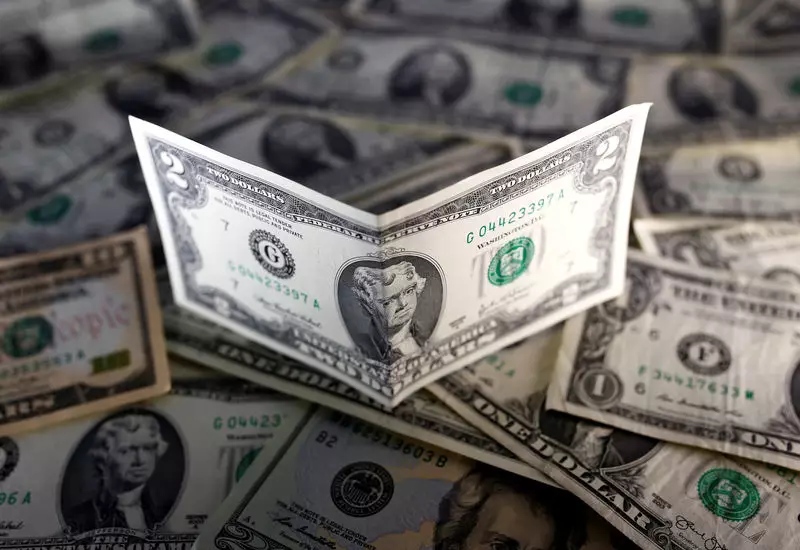In the dynamic landscape of foreign currency exchange, the U.S. dollar faces significant challenges, particularly following shifts in monetary policy by the Federal Reserve. Recent movements suggest that while there may be temporary fluctuations, the broader outlook for the dollar is increasingly tenuous. In contrast, some other currencies, especially the British pound, are gaining ground, reflecting differing economic signals across the Atlantic.
The U.S. dollar saw a slight uptick in trading on a Friday morning, yet it remains under pressure after the Federal Reserve announced a substantial 50 basis points cut in interest rates. This move signals a clear pivot towards a more accommodative monetary policy as the Fed seeks to support an economy facing various internal and external challenges. Even after this modest surprise in rate cuts, the dollar’s rise in value appears limited, resting just above a 12-month low on the Dollar Index.
Market analysts are now examining the potential trajectory for the dollar, particularly since the current trading suggests a significant level of uncertainty. Predictions indicate that there may be a 40% probability of another rate cut in November, with further reductions priced into the market’s future outlook. Long-term forecasts suggest that by 2025, interest rates could stabilize around 2.85%, which many economists believe aligns with the Federal Reserve’s neutral rate estimate. This sets the stage for a potential weakening of the dollar if economic indicators consistently suggest low inflation and sluggish growth.
Conversely, the British pound has enjoyed a resurgence in recent days, demonstrating resilience fueled by encouraging retail sales figures from the UK. Sterling rose by about 0.2% against the dollar, reaching a high not seen since March 2022. This strengthening can be attributed to better-than-anticipated retail sales data, which suggested a robust 1% increase in August, surpassing previous estimates. Moreover, this figure was bolstered by upward revisions to July’s performance, indicating an overall solid trend in consumer spending.
The Bank of England’s recent decision to maintain its interest rate at 5%, following an earlier rate cut, reflects a cautious approach to stimulating the economy without triggering inflation. Interestingly, this contrasts with the Fed’s more aggressive stance and highlights the divergent paths taken by central banks in response to varying economic conditions.
In the broader European context, the euro has remained relatively stable against the dollar, with minor fluctuations observed in the EUR/USD exchange rate. The European Central Bank recently implemented its second rate cut for the year, creating an uncertain environment in which the next moves remain unpredictable. Factors such as German producer prices that fell less than anticipated reveal underlying economic tensions that might influence future monetary policy.
As the eurozone navigates these economic headwinds, it could face challenges that stall its recovery. The data reflected in the steep price drops in producer prices suggests that inflationary pressures might not ease as quickly as hoped, complicating the European Central Bank’s strategies moving forward.
While the U.S. dollar struggles, the Japanese yen exhibits resilience despite ongoing pressure. Following the Bank of Japan’s decision to hold rates steady amidst rising inflation, the USD/JPY exchange rate indicated a 0.7% increase in dollar value against the yen. This situation underscores the complexity of analyzing currency performance against evolving economic forecasts. The Bank of Japan’s sentiment on inflation highlights significant consumer price pressures, suggesting the challenges Japan faces in managing its economic recovery.
Additionally, the People’s Bank of China’s decision to maintain the benchmark loan prime rate has raised eyebrows within the financial community. Despite expectations for a further rate cut to stimulate economic activity, the PBOC’s stance indicates a cautious approach amidst signs of weakening economic performance, particularly evident in various economic indicators.
Overall, the currency exchange landscape is marked by volatility, driven by differing monetary policy approaches and ongoing global economic dynamics. The U.S. dollar remains in a precarious position, while the British pound’s recent gains showcase the impact of positive economic data. As central banks recalibrate their strategies, traders and economists alike will need to analyze these indicators to navigate the shifting tides effectively. The interplay between currency values and interest rates will continue to capture attention as market participants respond to new data and evolving economic landscapes.

